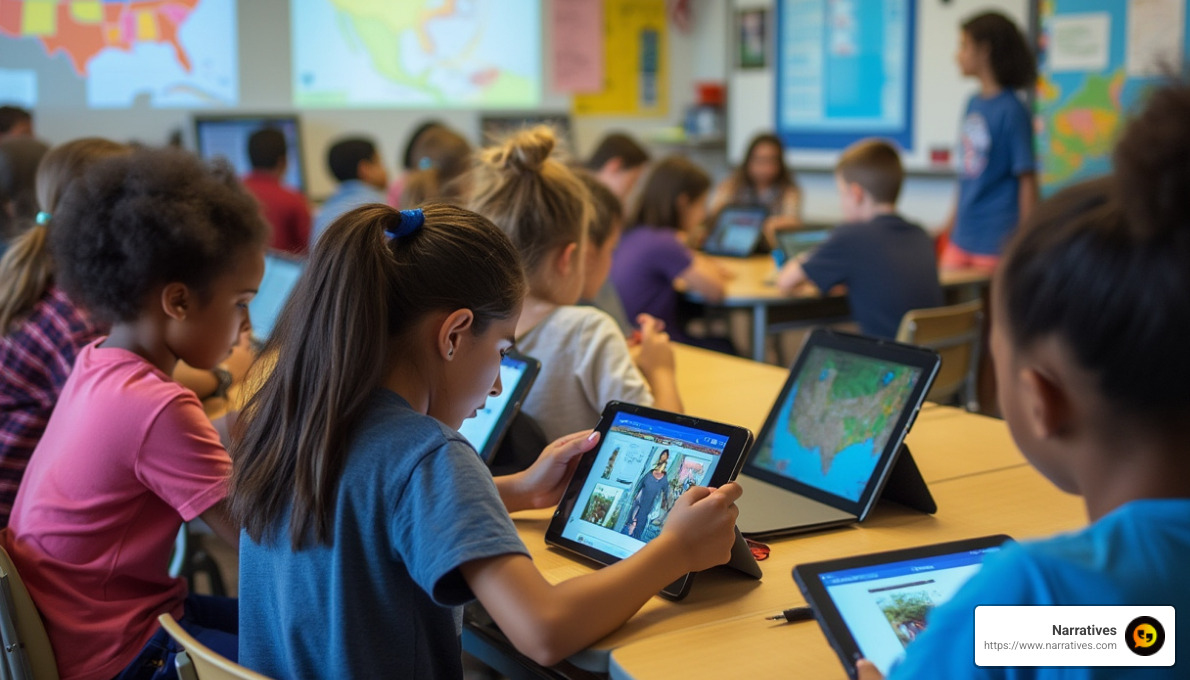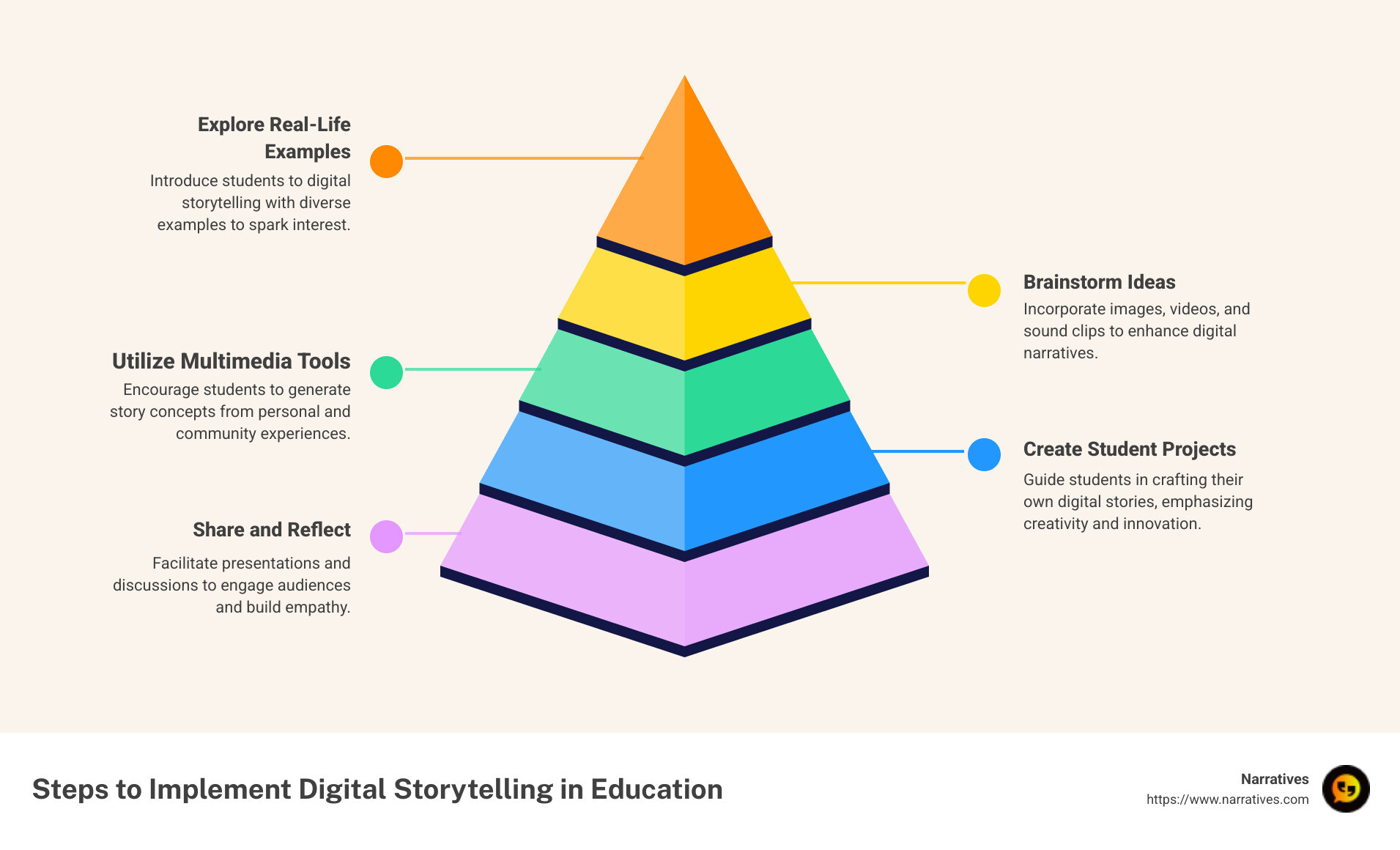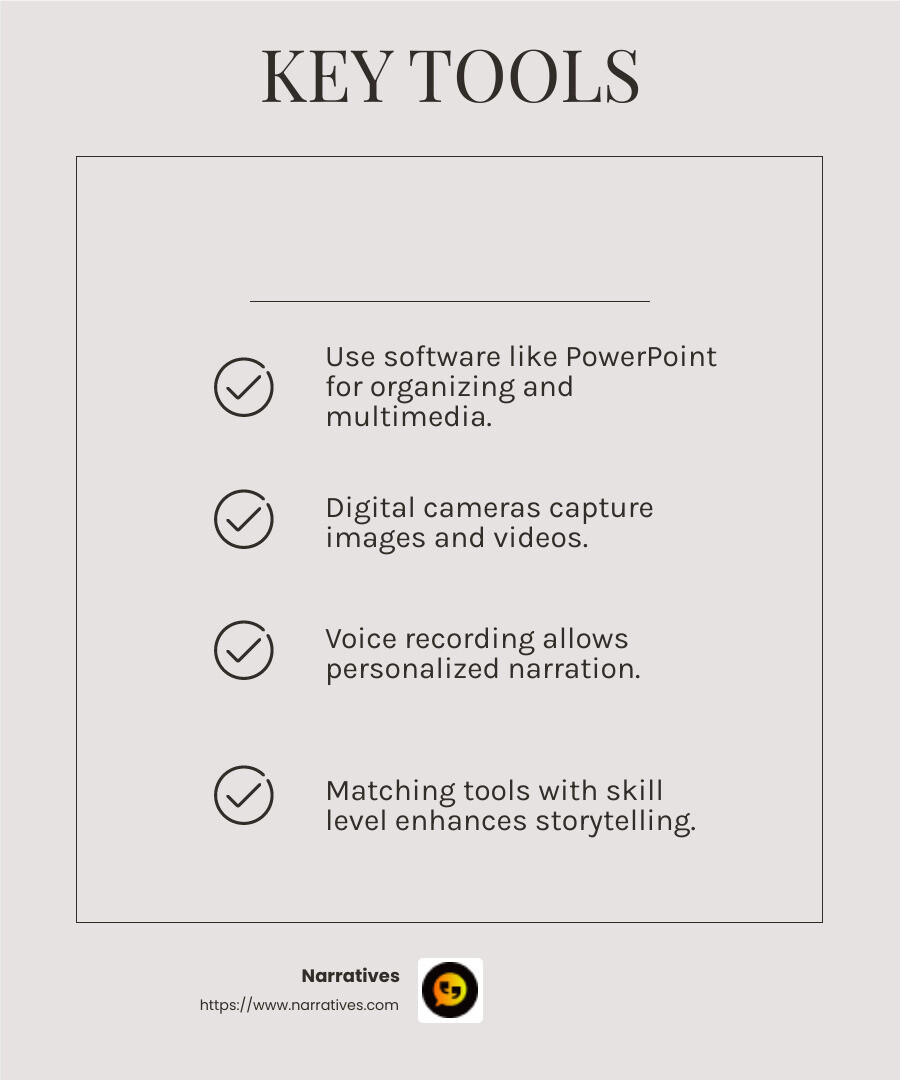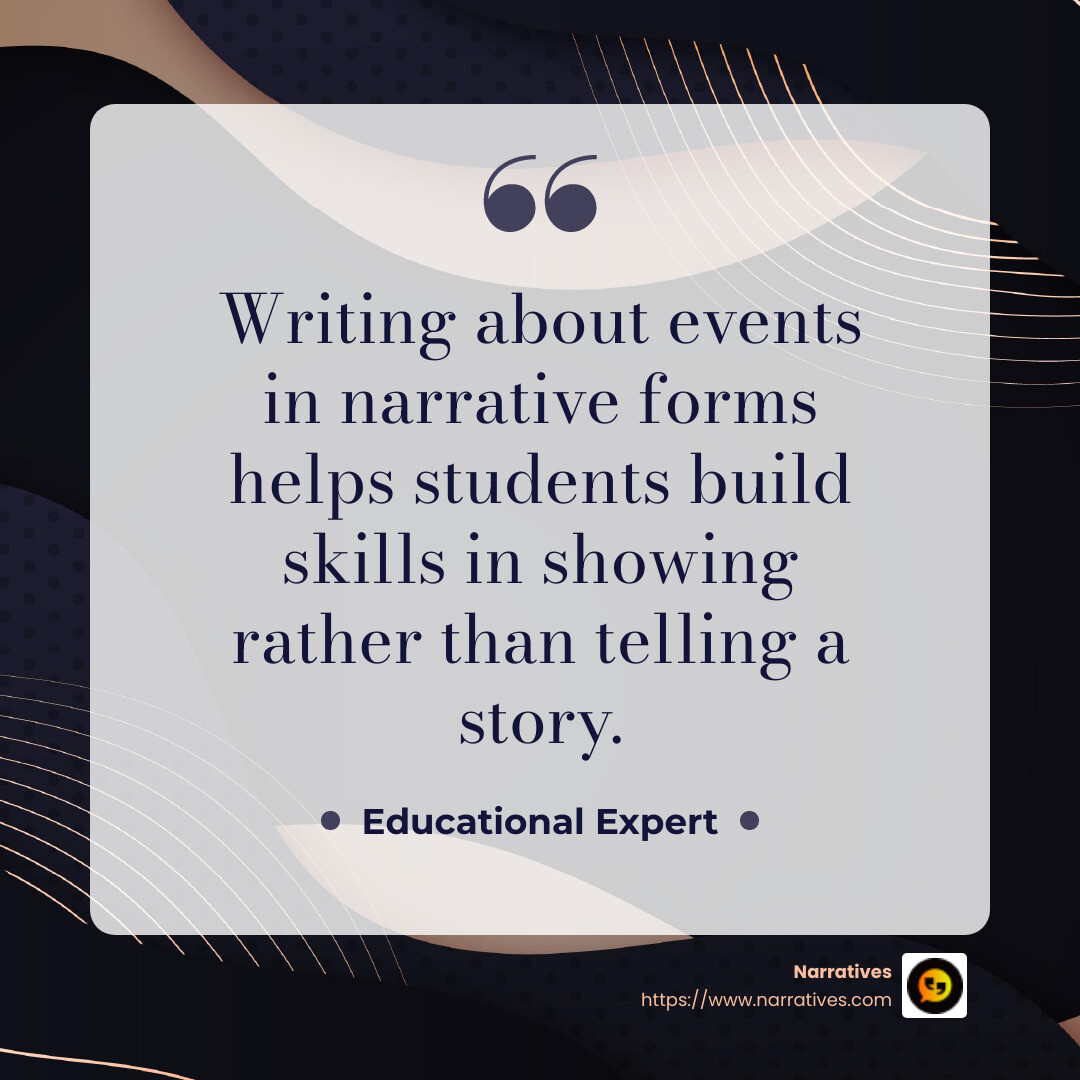Digital Storytelling Lesson Plans: A How-To Guide for Educators

Digital storytelling lesson plans are changing classrooms by integrating technology with traditional teaching methods, inspiring creativity, and enhancing communication skills. If you're an educator eager to bring digital storytelling into your lessons, here's how you can start:
- Introduce students to digital storytelling by exploring real-life examples and brainstorming ideas.
- Use multimedia tools to support storytelling, such as images, videos, and sound clips.
- Engage students in creating digital narratives, allowing them to express themselves innovatively.
Why is this important? Digital storytelling helps students not only engage with the curriculum more deeply but also develop essential skills like critical thinking and project management. From crafting personal narratives to exploring historical figures through digital documentaries, students learn to show rather than tell, enriching their academic and personal growth.
As we dive into this guide, we'll explore how digital storytelling can become a vital part of your educational toolkit.

Key digital storytelling lesson plans vocabulary:
- digital storytelling guide for educators
- tools for creating digital stories
- examples of digital storytelling in education
Understanding Digital Storytelling
Digital storytelling is a powerful educational tool that combines traditional storytelling elements with modern multimedia. It allows students to develop and improve their communication skills by expressing ideas through various digital formats.
Communication Skills
At the core of digital storytelling is communication. Students learn to construct narratives that are clear and engaging. They practice expressing opinions and emotions, which helps them become better communicators. By crafting stories, students also learn the art of "showing" rather than "telling," which is crucial for improving writing and storytelling abilities.
"Writing about events in narrative forms helps students build skills in showing rather than telling a story."
Multimedia Integration
Digital storytelling uses multimedia elements like images, sound, and video to bring stories to life. This integration helps students become literate in various media forms, enhancing their ability to interpret and create content. For example, adding sound effects or music can change the tone and mood of a story, making it more immersive.
Multimedia tools can include:
- Images: Visuals help illustrate and emphasize key points in a story.
- Audio: Narration and sound effects add depth and engagement.
- Video: Moving images can make a story more dynamic and captivating.
Storytelling Process
The process of creating a digital story involves several steps, each building different skills:
- Idea Generation: Students brainstorm topics, often drawing from personal experiences or community stories.
- Storyboarding: They plan the visual sequence and transitions, organizing their narrative structure.
- Drafting: Writing the script, focusing on clear and compelling storytelling.
- Editing and Finalizing: Adding digital elements like images and audio to improve the story.
- Sharing: Presenting the final product to an audience, fostering feedback and discussion.
This process not only engages students but also teaches them valuable project management skills. They learn to handle different tasks, work collaboratively, and meet deadlines.
Digital storytelling transforms the way students engage with content. It fosters a deeper understanding of subjects and helps them become powerful communicators. We'll explore how to create effective digital storytelling lesson plans that leverage these benefits.
Creating Digital Storytelling Lesson Plans
Designing digital storytelling lesson plans is an exciting opportunity for educators to blend creativity with technology. Let's explore how you can set up these plans effectively.
Selecting Appropriate Tools
Choosing the right tools is crucial for successful digital storytelling. The goal is to match the technology with your students' skill levels and the story they want to tell.
Key Tools to Consider:
- Software: Word processing and presentation software like PowerPoint are great starting points. They allow students to organize their narratives and add multimedia elements easily.
- Digital Cameras: These are perfect for capturing images and videos that can bring stories to life.
- Voice Recording: Most computers come with built-in voice recording tools. Students can use these to narrate their stories, adding a personal touch.
>
Engagement Tip: Pair students with varying skill levels to foster peer learning. This not only helps them learn from each other but also encourages collaboration.
Developing Story Ideas
The first step in storytelling is generating ideas. Encourage students to brainstorm topics that resonate with them.
Brainstorming Techniques:
- Personal Experiences: Students can draw from their own lives. This makes stories more authentic and relatable.
- Community Stories: Encouraging students to explore their community can lead to rich, diverse narratives. They can interview local figures or highlight community events.
Activity Suggestion: Use post-it notes or index cards to jot down ideas and arrange them on a storyboard. This visual approach helps students see the flow of their story.
Story Idea Sources:
- Family and Pets: These are often filled with humor and emotion, making them great storytelling subjects.
- School Events: Sports days, science fairs, or school plays can provide a backdrop for engaging stories.
The key is to keep the process open and encourage creativity. By allowing students to choose topics meaningful to them, you increase their investment in the storytelling process.
Digital storytelling lesson plans are about more than just creating stories. They're about engaging students in a way that improves their learning and communication skills. In the next section, we'll explore how to implement these plans in the classroom effectively.
Implementing Digital Storytelling in the Classroom
Drafting and Storyboarding
Once students have their story ideas, it's time to bring them to life with drafting and storyboarding. This step is crucial as it lays the foundation for the entire digital storytelling project.
Group Activities for Drafting:
- Collaborative Writing: Encourage students to work in pairs or small groups to write their story drafts. This promotes teamwork and allows them to bounce ideas off each other.
- Peer Feedback: After drafting, have students exchange their stories for peer review. This helps improve their stories and fosters a collaborative environment.
Creating a Storyboard:
A storyboard is a visual representation of the story. It helps students plan the visual sequence and organize their thoughts.
- Use Sticky Notes: Provide students with colored sticky notes to jot down key scenes and arrange them on a storyboard template. This makes it easy to rearrange scenes as needed.
- Discuss Visual Elements: Talk about what images or videos will accompany each part of the story. Encourage students to think about the emotions they want to convey through visuals.
Focus on Transitions:
Transitions are key to a smooth storytelling experience. Discuss different types of transitions—such as fades, cuts, or dissolves—and how they can affect the story's flow.
Finalizing and Sharing Stories
With the storyboard in place, students can move on to finalizing their stories, adding digital elements, and preparing for audience engagement.
Narration and Digital Elements:
- Record Narration: Guide students in recording their narrative. This adds a personal touch and helps convey the story's tone.
- Incorporate Multimedia: Encourage the use of digital elements like sound effects, music, and animations to improve the story. Remind students to use these elements to support the narrative, not overshadow it.
Audience Engagement:
Sharing stories is a vital part of the digital storytelling process. It provides students with an opportunity to engage with an audience and receive feedback.
- Class Presentations: Host a storytelling day where students present their stories to the class. This builds confidence and public speaking skills.
- Online Sharing: Consider sharing stories on a class blog or website. This widens the audience and allows family and friends to view the students' work.
By focusing on drafting, storyboarding, and finalizing, educators can guide students through the entire storytelling process. This not only improves their technical skills but also boosts their creativity and collaboration abilities, setting the stage for a rewarding educational experience.
Benefits of Digital Storytelling for Students
Digital storytelling is more than just a creative outlet. It offers students a chance to improve various skills that are crucial for their personal and academic growth. Let's explore how this approach benefits students in three key areas: creativity, critical thinking, and empathy.
Boosting Creativity
Digital storytelling encourages students to think outside the box. By combining text, images, and sound, they can bring their stories to life in unique ways. This process nurtures their creative abilities and helps them express themselves more freely.
- Visual and Sound Literacy: As students choose images and sounds to match their narratives, they learn to communicate visually and aurally, expanding their literacy skills beyond traditional reading and writing.
- Innovative Storytelling: Students can explore different storytelling styles, such as myths, legends, or personal narratives, allowing them to experiment with various creative techniques.
Enhancing Critical Thinking
Critical thinking is a cornerstone of digital storytelling. Students must analyze and synthesize information to create compelling stories.
- Research and Analysis: Whether crafting a biography or a historical docudrama, students engage in extensive research, evaluating sources and selecting relevant information to support their narratives.
- Problem-Solving: Throughout the storytelling process, students encounter challenges that require them to think critically and develop solutions, such as finding the best way to convey a complex idea visually.
Fostering Empathy
Empathy is the ability to understand and share the feelings of others. Digital storytelling provides a platform for students to explore diverse perspectives and develop a deeper sense of empathy.
- Exploring Different Perspectives: By telling stories from various viewpoints, such as those of historical figures or fictional characters, students learn to see the world through different lenses.
- Connecting Personal Experiences: Sharing personal stories or those of their community helps students connect with others on an emotional level, fostering a sense of empathy and understanding.
Incorporating digital storytelling into the classroom not only improves students' technical skills but also enriches their emotional and intellectual development. By embracing creativity, critical thinking, and empathy, students are better prepared to steer the complexities of the modern world.
Frequently Asked Questions about Digital Storytelling Lesson Plans
Creating digital storytelling lesson plans can be an exciting yet complex task for educators. Here, we'll address some common questions to help you steer the process effectively.
What are the key elements of digital storytelling?
Digital storytelling combines traditional storytelling with digital elements, enhancing the narrative through multimedia. Here are the key elements:
- Point of View: The main perspective or message of the story.
- A Dramatic Question: A central question that keeps the audience engaged.
- Emotional Content: Elements that connect the audience emotionally to the story.
- Voice: Personalizing the story through narration.
- Soundtrack: Music or sound effects that improve the storytelling.
- Economy: Being concise, focusing on the essence of the story.
- Pacing: The rhythm and speed at which the story unfolds.
Understanding these elements can help students craft compelling digital stories that resonate with their audience.
How can digital storytelling improve learning?
Digital storytelling is a powerful educational tool that improves learning in several ways:
- Engagement: Students are more engaged when they can use multimedia to express their ideas.
- Collaboration: Group storytelling activities foster teamwork and communication skills.
- Critical Thinking: Analyzing and organizing information into a coherent story boosts critical thinking.
- Creativity: Encourages students to be innovative in how they present their stories.
- Empathy: By exploring different perspectives, students develop a deeper understanding of others.
These benefits make digital storytelling an effective method for enhancing both academic and social skills.
What tools are recommended for digital storytelling?
Choosing the right tools is crucial for successful digital storytelling. Here are some recommended options:
- Software: Tools like Adobe Spark, iMovie, or Storybird offer user-friendly interfaces for creating digital stories.
- Digital Cameras: Simple cameras or smartphones can be used for capturing images and videos.
- Voice Recording: Apps like Audacity or GarageBand are great for recording and editing narration.
- Image and Sound Libraries: Resources such as Pics4Learning provide copyright-friendly images and sounds for educational use.
Selecting appropriate tools ensures that students can focus on storytelling rather than technical challenges, making the process smoother and more enjoyable.
Conclusion
Digital storytelling is more than just a creative exercise; it's a powerful tool for driving social impact and fostering community-driven storytelling. At Narratives, we believe in the transformative potential of stories, especially those from underrepresented voices. By integrating digital storytelling into educational settings, we empower students to tell their own stories and understand the stories of others.
Narratives is committed to partnering with non-profits and purpose-driven organizations to craft high-quality multimedia content. Our focus on elevating diverse voices helps build empathy and inspire action. Through digital storytelling, students not only learn to create compelling narratives but also contribute to a larger dialogue about social change and community engagement.
Incorporating digital storytelling into lesson plans allows educators to nurture creativity, critical thinking, and empathy among students. It equips them with the skills to engage meaningfully with their communities and the world. As they share their stories, they contribute to a mix of voices that can drive awareness and inspire change.
By embracing digital storytelling, educators can transform their classrooms into spaces where every voice is heard, and every story matters. This approach not only enriches the learning experience but also helps build a more inclusive and connected world.
For more on how we can help you harness the power of storytelling, explore our services. Together, let's amplify stories that matter.



